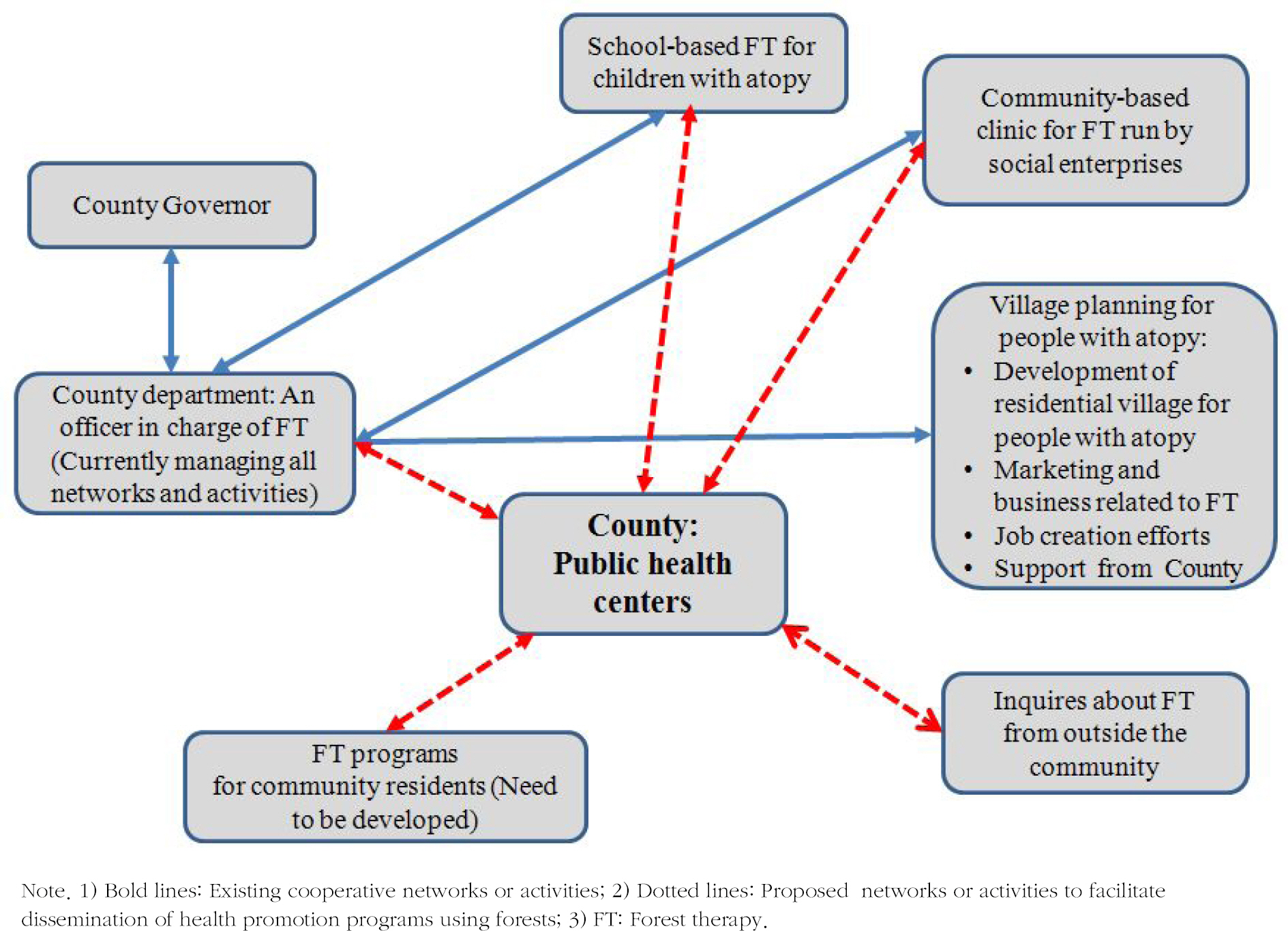Perspect Nurs Sci.
2014 Apr;11(1):30-38.
An Exploratory Study of Diffusion of Health Promotion Programs using Forests
- Affiliations
-
- 1Professor, College of Nursing, Seoul National University, Seoul, Korea.
- 2Associate Professor, College of Nursing, Seoul National University, Seoul, Korea. hchoi20@snu.ac.kr
- 3Doctoral Student, College of Nursing, Seoul National University, Seoul, Korea.
Abstract
- PURPOSE
In recent years, many attempts have been made to examine the effects of forest therapy on health and to develop related policies. This study aimed to explore the current status of health promotion programs using forests provided by public health centers and to identify program diffusion strategies employed within different communities.
METHODS
For this descriptive study, we analyzed the 5th regional public health care program plans and explored the perceptions of health care workers attached with the programs using open-ended questionnaires and a focus group interview.
RESULTS
This study confirmed the necessity for health promotion programs using forests, as well as administrative and educational demands for such programs. The target population of the programs ranged from individuals with specific diseases to healthy local residents. In addition, the programs covered a wide range of topics, including disease management and health promotion strategies. However, the number of well-structured regional specialized programs remained limited. Collaboration among local governments, schools, and public health centers was found to be ineffective.
CONCLUSION
To further disseminate health promotion programs using forests, the central government will need to develop well-structured programs, provide funding and resources to support local governments, and focus on raising public awareness of the health benefits of forest therapy.
Keyword
MeSH Terms
Figure
Reference
-
References
1. Korea Forest Service. [Forest Welfare Master Plan]. Daejeon: Korea Forest Service;2013.2. KimKW.Theoreticalstudy of characteristics of therapeutic elements and application to forest therapy. J Korean Soc People Plants Environ. 2006; 9(4):111–23.3. Kim KW. Technical methods for enhancing the health effect intherecreational forest. J KoreanSoc PeoplePlants Environ. 1999; 2(4):1–11.4. Kang MJ, Kwak KH, Ahn YS, An KW, Kim EI. Basic plan for creating a healing forest in Jangheunggun. J Korean isl. 2011; 23(2):103–20.5. Cha J, Kim S. Healing effects of the forest experience on alcoholics. J Korean Acad Nurs. 2009; 39(3):338–48. http://dx.doi.org/10.4040/jkan.2009.39.3.338.
Article6. Lee JH.Characteristicsof naturebased recreation inGermany – a view from the historical background and laws. J Korean Inst For Recreat. 2010; 14(4):81–91.7. Maller C, TownsendM , Pryor A, BrownP , St Leger L. Healthy nature healthy people: ‘contact with nature' as an upstream health promotion intervention for populations. Health Promot Int. 2006; 21(1):45–54. http://dx.doi.org/10.1093/heapro/dai032.
Article8. Frumkin H. Healthy places: exploring the evidence. Am J Public Health. 2003; 93(9):1451–6.
Article9. Yoo RH, Kim JW, Ha SY, Yoon EY, Kim JJ.Analysis of the internal and external case using therapeutic function of forests. In: [KoreanForest SocietyConference]; 2007Aug 30–31; Wonju, Korea. Seoul: Korean Forest Society;2007. p. 462–3.10. Woo JM, Park SM, Lim SK, Kim W. Synergistic effect of forest environment and therapeutic program for the treatment of depression. J Korean For Soc. 2012; 101(4):677–85.11. Kim S, Kim HJ, Lee KJ, Lee SO. [Focus Interview Method]. Seoul: Hyunmoon;2000.12. Forest Therapy Society. Forest Therapy Total Web [Internet]. [place unknown]: Forest Therapy Society; [cited 2013 Feb 5]. Available from:. http://www.fo-society.jp.13. An KW, Lee KH, Jeon KS, Yoo RH, Park JS, Kim SL. A case study of forest therapeutic programs in Japan. In: [2007 Conference of Korean Institute of Forest Recreation]; 2007 Apr; Korea. [place unknown]: Korean Institute of Forest Recreation;. 2007. 61–7.15. Lee JH, Burger-Arndt R. Understanding the healing function of urban forests in German cities. J Korean Inst For Recreat. 2011; 15(3):81–9.16. Kim SC, Han YH, Park KU, Oh HK. Improvement methods of theforest therapeutic functioninrecreational forest. J Korean Inst For Recreat. 2008; 12(4):1–8.
- Full Text Links
- Actions
-
Cited
- CITED
-
- Close
- Share
- Similar articles
-
- An Analysis of Health Promotion Programs Utilizing Forests based on Korea's Regional Healthcare Program Plans
- Elementary School Teachers' Awareness of Forest Welfare Services and Promotion of Strategies for School-based Health Promotion Programs Using the Forest
- Factors Influencing Workers' Need for Health Promotion Programs
- A Proposal of Health Promotion Program for Overweight Schoolchildren
- A Systematic Review of Forest Therapy Programs for Elementary School Students


